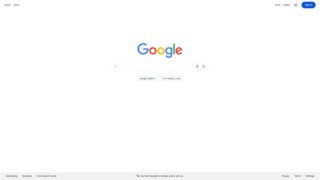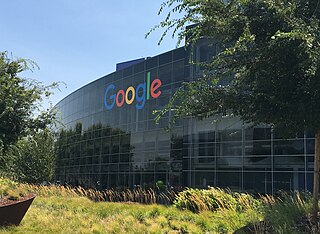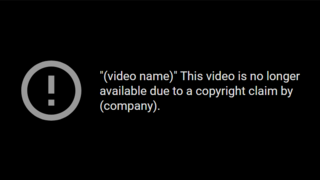Related Research Articles

Google Search is a search engine operated by Google. It allows users to search for information on the Internet by entering keywords or phrases. Google Search uses algorithms to analyze and rank websites based on their relevance to the search query. It is the most popular search engine worldwide.

Google LLC is an American multinational technology company focusing on artificial intelligence, online advertising, search engine technology, cloud computing, computer software, quantum computing, e-commerce, and consumer electronics. It has been referred to as "the most powerful company in the world" and as one of the world's most valuable brands due to its market dominance, data collection, and technological advantages in the field of artificial intelligence. Google's parent company Alphabet Inc. is one of the five Big Tech companies, alongside Amazon, Apple, Meta, and Microsoft.

YouTube is an American online video sharing and social media platform owned by Google. Accessible worldwide, it was launched on February 14, 2005, by Steve Chen, Chad Hurley, and Jawed Karim, three former employees of PayPal,. Headquartered in San Bruno, California, United States, it is the second most visited website in the world, after Google Search. YouTube has more than 2.5 billion monthly users, who collectively watch more than one billion hours of videos every day. As of May 2019, videos were being uploaded to the platform at a rate of more than 500 hours of content per minute, and as of 2023, there were approximately 14 billion videos in total.
Google and its subsidiary companies, such as YouTube, have removed or omitted information from its services in order to comply with company policies, legal demands, and government censorship laws.

Jawed Karim is an American software engineer and Internet entrepreneur. He is a co-founder of YouTube and the first person to upload a video to the site. The site's inaugural video, "Me at the zoo", uploaded on April 23, 2005, has been viewed over 309 million times as of February 24, 2024. During Karim's time working at PayPal, where he met fellow YouTube co-founders Steven Chen and Chad Hurley, he designed many of its core components, including its real-time anti-fraud system.

Chad Meredith Hurley is an American webmaster and businessman who serves as the advisor and former chief executive officer (CEO) of YouTube. He also co-founded MixBit. In October 2006, he and Steve Chen sold YouTube for $1.65 billion to Google. Hurley worked in eBay's PayPal division—one of his tasks involved designing the original PayPal logo—before co-founding YouTube with fellow PayPal colleagues Steve Chen and Jawed Karim. Hurley was primarily responsible for the tagging and video-sharing aspects of YouTube.
Vimeo, Inc. is an American video hosting, sharing, and services platform provider headquartered in New York City. Vimeo focuses on the delivery of high-definition video across a range of devices. Vimeo's business model is through software as a service (SaaS). They derive revenue by providing subscription plans for businesses and content creators. Vimeo provides its subscribers with tools for video creation, editing, and broadcasting, enterprise software solutions, as well as the means for video professionals to connect with clients and other professionals. As of December 2021, the site has 260 million users, with around 1.6 million subscribers to its services.

Lisa Donovan is an American former YouTuber. She is a founder of Zappin Productions, a production company that specialized in viral videos, as well as the founder and CEO of The Pattern, an astrology-based personality app.
Criticism of Google includes concern for tax avoidance, misuse and manipulation of search results, its use of others' intellectual property, concerns that its compilation of data may violate people's privacy and collaboration with the US military on Google Earth to spy on users, censorship of search results and content, and the energy consumption of its servers as well as concerns over traditional business issues such as monopoly, restraint of trade, antitrust, patent infringement, indexing and presenting false information and propaganda in search results, and being an "Ideological Echo Chamber".

YouTube is an American online video-sharing platform headquartered in San Bruno, California, founded by three former PayPal employees—Chad Hurley, Steve Chen, and Jawed Karim– in February 2005. Google bought the site in November 2006 for US$1.65 billion, since which it operates as one of Google's subsidiaries.

LeapFish.com was a search aggregator that retrieved results from other portals and search engines, including Google, Bing and Yahoo!, and also search engines of blogs, videos etc. It was a registered trademark of Dotnext Inc, launched on 3 November 2008.

DuckDuckGo is an American software company that offers a number of software products oriented towards helping people protect their privacy online. The company also provides a private search engine, a tracker-blocking browser extension, email protection, and app tracking protection.

Salar Kamangar is an Iranian-American senior executive at Google and former CEO of Google's YouTube brand.

Pinterest is an American image sharing and social media service designed to enable saving and discovery of information like recipes, home, style, motivation, and inspiration on the internet using images and, on a smaller scale, animated GIFs and videos, in the form of pinboards. Created by Ben Silbermann, Paul Sciarra, and Evan Sharp, Pinterest, Inc. is headquartered in San Francisco.

Susan Diane Wojcicki is an American business executive who was the chief executive officer (CEO) of YouTube from 2014 to 2023. Her net worth was estimated at $765 million in 2022.
YouTube copyright issues relate to how the Google-owned site implements its protection methods. The systems are designed to protect the exclusivity of a given creator and owner and the rights to reproduce their work. YouTube uses automated measures such as copyright strikes, Content ID and Copyright Verification Program. These methods have been criticized for favoring corporations and their use of copyright claims to limit usage of uploaded content.

YouTube copyright strike is a copyright policing practice used by YouTube for the purpose of managing copyright infringement and complying with the Digital Millennium Copyright Act (DMCA). The DMCA is the basis for the design of the YouTube copyright strike system. For YouTube to retain DMCA safe harbor protection, it must respond to copyright infringement claims with a notice and take down process. YouTube's own practice is to issue a "YouTube copyright strike" on the user accused of copyright infringement. When a YouTube user gets hit with a copyright strike, they are required to watch a warning video about the rules of copyright and take trivia questions about the danger of copyright. A copyright strike will expire after 90 days. However, if a YouTube user accumulates three copyright strikes within those 90 days, YouTube terminates that user's YouTube channel, including any associated channels that the user have, removes all of their videos from that user's YouTube channel, and prohibits that user from creating another YouTube channel.

WebTorrent is a peer-to-peer (P2P) streaming torrent client written in JavaScript, from the same author, Feross Aboukhadijeh, of YouTube Instant, and the team at WebTorrent and on GitHub, for use in web browsers, as well as a WebTorrent Desktop stand alone version able to bridge WebTorrent and BitTorrent serverless networks.
YouTube Shorts is the short-form section of the American video-sharing app YouTube. Shorts focuses on vertical videos at a maximum length of 60 seconds and various features for user interaction. As of January 2022, Shorts have collectively earned over 5 trillion views since the platform was made available to the public on July 13, 2021, which include video views that pre-date the YouTube Shorts feature. Creators earn money based on the amount of views they receive, or through ad revenue. The increased popularity of YouTube Shorts has led to concerns about addiction for teenagers.
References
- ↑ "Youtube Instant". Ghacks.net. 11 September 2010. Retrieved 2010-09-12.
- 1 2 "Student Creator of 'YouTube Instant' Offered YouTube Job". digitalmediawire. Retrieved 2010-09-12.
- 1 2 3 4 5 "YouTube Instant Creator Worked on Secret Facebook Project" . Retrieved 2010-09-12.
- ↑ Blodget, Henry (September 10, 2010). "YouTube Instant". Businessinsider.com. Retrieved 2010-09-12.
- ↑ Ehrlich, Brenna (2010-09-10). "Google Instant Is Cool, But Check Out YouTube Instant". Mashable.com. Retrieved 2010-09-12.
- ↑ Kafka, Peter. "A Completely Excellent Way to Waste 15 Minutes: "YouTube Instant"" . Retrieved 2010-09-12.
- ↑ Beckham, John (2010-09-16). "YouTube Instant and Instant Search For Images & Google Maps". ICT Magazine. Archived from the original on 2011-07-05.
- ↑ John 10:10 AM (CST). "[H]ard|OCP - Youtube and Maps Instant". Hardocp.com. Archived from the original on 2012-09-10. Retrieved 2010-09-12.
{{cite web}}: CS1 maint: numeric names: authors list (link) - ↑ Lynley, Matthew (September 10, 2010). "Stanford student creates YouTube Instant, gets job offer from YouTube CEO". VentureBeat. Retrieved 2010-09-12.
- ↑ Lynley, Matthew (September 10, 2010). "Instant student creates YouTube and contacted via Twitter to work on the video site" . Retrieved 2010-09-12.
- ↑ "College Kid Makes 'YouTube Instant,' Gets Instant YouTube Job Offer". Gawker.com. Retrieved 2010-09-12.
- ↑ Kwek, Glenda (2010-09-13). "Instant fame: how to get a job ... without even searching". Sydney Morning Herald. Retrieved 2010-09-12.
- ↑ "Google Instant Search to be Introduced on New Sites by Third-Party Mashups". Weeble. Retrieved 2010-09-13.
- 1 2 "'YouTube Instant' creator finds instant fame". cnet news. Retrieved 2010-09-13.
- 1 2 3 "Stanford student launches YouTube Instant". Computers & Technology: Internet. 2010-09-12. Archived from the original on 2010-09-13. Retrieved 2010-09-12.
- ↑ "College Kid Makes 'YouTube Instant,' Gets Instant YouTube Job Offer" . Retrieved 2010-09-16.
- ↑ Lynley, Matthew (2010-09-10). "Stanford Student Creates YouTube Instant, Gets Job Offer From YouTube CEO". The New York Times. Retrieved 2010-09-16.
- ↑ "Top Technology News: Stanford student gets instant fame with YouTube Instant". 13 September 2010. Retrieved 2010-09-16.
- ↑ "YouTube Instant Developed by Stanford Junior" . Retrieved 2010-09-16.
- ↑ "Youtube Instant" . Retrieved 2010-09-16.
- ↑ "'YouTube Instant' creator finds instant fame".
- ↑ "YouTube Instant". Business Insider . Retrieved 2010-09-16.
- ↑ "'YouTube Instant' Creator Still in College, Nabs Job Offer Via Twitter" . Retrieved 2010-09-16.
- ↑ "Uni Student Makes YouTube Instant, Gets Instant YouTube Job Offer" . Retrieved 2010-09-16.
- ↑ "Cómo hacerse famoso y humillar a YouTube en tres horas" . Retrieved 2010-09-16.
- ↑ "YouTube Instant delivers your gratification even more quickly" . Retrieved 2010-09-16.
- ↑ "A College Student Develops Youtube Instant". 16 September 2010. Retrieved 2010-09-16.
- ↑ "AddTV: Student creates YouTube Instant". YouTube . Archived from the original on 2021-12-21. Retrieved 2010-09-12.
- ↑ "Top Technology News: Stanford student gets instant fame with YouTube Instant". NJ.com. 13 September 2010. Retrieved 2010-09-20.
- ↑ "Stanford student creates YouTube Instant, gets job offer from YouTube CEO". 10 September 2010. Retrieved 2010-09-13.
- ↑ "Feross.org" . Retrieved 2010-09-13.
- ↑ Go Viral on Youtube
- ↑ ""YouTube Instant" Dude Can't Go to Work for Chad Hurley, Because He's Already Working for Mark Zuckerberg" . Retrieved 2010-09-12.
- ↑ "'YouTube Instant' creator, 19, finds instant fame" . Retrieved 2010-09-12.
- ↑ "YouTube Instant and Google Maps Instant Follow in Google Instant's Footsteps". Lifehacker.com. 2010-09-11. Retrieved 2010-09-20.
- ↑ "iTunes Goes Instant, Thanks to 15-Year-Old". Fast Company. Retrieved 2010-09-13.
- ↑ "Instantly look up definitions & word meanings!". Instantionary.com. Retrieved 2010-09-20.
- ↑ "Search PubMed Instantly!". PMinstant.com. Retrieved 2010-09-20.
- ↑ "Search Wikipedia Instantly!". WikInstant.com. Retrieved 2010-09-20.
- ↑ "Search Wikipedia as you type!". The Instant Wiki. Retrieved 2010-09-20.
- 1 2 "Google Maps and Images Get the (Unofficial) Instant Treatment". Fast Company. 11 September 2010. Retrieved 2010-09-13.
- ↑ Murphy, David (2010-09-12). "'Instantise' Combines Most Popular 'Instant' Search Spin-offs". PCMAG. Retrieved 2010-09-13.